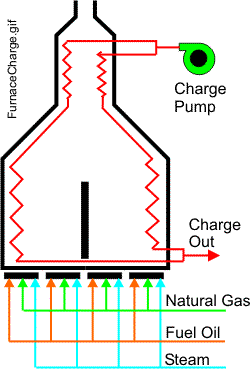 |
Furnace Charge
Many refinery processes require the feed fluid to be heated to very high temperatures, sometimes as high as 1400 deg. F (760 deg. C). To accomplish this feed fluid is passed through an assembly of tubes that are located in a furnace.
The figure provided here illustrates how a pump (called the “charge pump”) is used to pump the liquid to be heated through tubes that are located inside a furnace. Notice that the charge fluid is divided into many parallel paths as it traverses through the furnace box. At the exit point, all of the parallel paths are re-combined and the heated fluid is routed to the process unit.
Usually a furnace is fired by natural gas or fuel oil. Some of the heavier oils require atomization, for this purpose steam is also provided to the burners.
Usually furnaces are identified by large box-like structures, wide at the bottom, and equipped with tall stacks (chimneys). The stacks are about 5 feet in diameter and about a hundred or more feet tall.